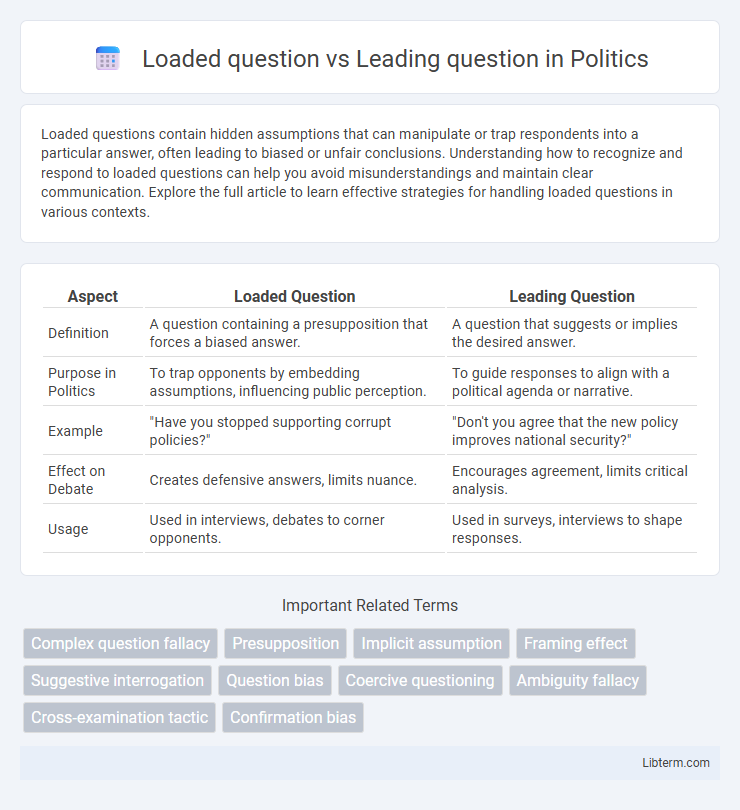Loaded questions contain hidden assumptions that can manipulate or trap respondents into a particular answer, often leading to biased or unfair conclusions. Understanding how to recognize and respond to loaded questions can help you avoid misunderstandings and maintain clear communication. Explore the full article to learn effective strategies for handling loaded questions in various contexts.
Table of Comparison
| Aspect | Loaded Question | Leading Question |
|---|---|---|
| Definition | A question containing a presupposition that forces a biased answer. | A question that suggests or implies the desired answer. |
| Purpose in Politics | To trap opponents by embedding assumptions, influencing public perception. | To guide responses to align with a political agenda or narrative. |
| Example | "Have you stopped supporting corrupt policies?" | "Don't you agree that the new policy improves national security?" |
| Effect on Debate | Creates defensive answers, limits nuance. | Encourages agreement, limits critical analysis. |
| Usage | Used in interviews, debates to corner opponents. | Used in surveys, interviews to shape responses. |
Introduction to Loaded and Leading Questions
Loaded questions embed presuppositions that force a specific response, often implying guilt or bias, while leading questions suggest an answer within the query itself, steering the respondent towards a particular conclusion. Both question types manipulate the respondent's answer by framing the inquiry to influence perception and interpretation. Understanding these distinctions is crucial in legal, psychological, and survey contexts to ensure objective and fair information gathering.
Defining Loaded Questions
A loaded question contains an implicit assumption that traps the respondent, often making any direct answer appear as an admission of something unfavorable. It is designed to corner the person answering by embedding controversial or biased premises within the query. Understanding this distinction clarifies how loaded questions manipulate responses compared to leading questions, which subtly guide the respondent toward a particular answer without necessarily containing a hidden assumption.
Defining Leading Questions
Leading questions subtly prompt respondents toward a specific answer by implying or suggesting a preferred response within the question itself. Unlike loaded questions that contain built-in assumptions often designed to trap or confuse, leading questions influence opinions through phrasing or tone, guiding answers without overt bias. This technique is frequently used in surveys, interviews, and legal settings to shape or confirm desired outcomes.
Key Differences Between Loaded and Leading Questions
Loaded questions contain implicit assumptions that force a specific response, often trapping the respondent into admitting something controversial or unfair. Leading questions subtly suggest the desired answer within the question itself, guiding respondents toward a particular reply without explicitly stating it. Key differences lie in intent and construction: loaded questions embed presuppositions that constrain answers, while leading questions influence answers through phrasing and tone.
Common Examples of Loaded Questions
Common examples of loaded questions include inquiries like "Have you stopped cheating on exams?" or "Why do you support harmful policies?" These questions presuppose guilt or a negative trait, forcing the respondent into a corner regardless of their answer. Loaded questions manipulate the conversation by embedding assumptions that bias the response and limit honest dialogue.
Common Examples of Leading Questions
Common examples of leading questions include phrases like "You were at the scene of the crime, weren't you?" which suggest the desired answer. In surveys, questions such as "How satisfied are you with our excellent customer service?" bias respondents toward positive feedback. These questions guide respondents by implying a preferred response, often undermining objective and unbiased answers.
Psychological Impact of Each Question Type
Loaded questions often induce cognitive dissonance, compelling respondents to confront implicit assumptions embedded within the query, which can result in feelings of guilt or defensiveness. Leading questions subtly steer individuals toward a predetermined answer by framing the inquiry with suggestive language, thereby influencing belief formation and decision-making processes. Both question types manipulate psychological responses, but loaded questions can create internal conflict while leading questions shape external attitudes.
How to Recognize Loaded vs Leading Questions
Loaded questions contain implicit assumptions that trap the respondent into agreeing with a presupposition, often making it difficult to answer without appearing guilty or contradictory. Leading questions suggest a specific answer by phrasing the query in a way that prompts or biases the respondent toward a desired response. To recognize loaded questions, identify hidden premises or emotionally charged language, while leading questions can be detected by noting if the question implies a preferred answer or includes suggestive wording.
Implications in Surveys, Law, and Everyday Conversations
Loaded questions embed presuppositions that can bias responses, skewing survey data accuracy and potentially invalidating legal testimonies. Leading questions subtly influence the respondent toward a desired answer, undermining the objectivity of witness statements and distorting public opinion research. Both question types compromise the reliability of information in everyday conversations by restricting genuine expression and reinforcing confirmation bias.
Tips to Avoid Using or Falling for These Question Types
To avoid using or falling for loaded questions, carefully identify if a question contains assumptions that force a specific answer, and respond by challenging or reframing the premise. For leading questions, recognize when a query subtly suggests the desired response, and answer by providing neutral, fact-based replies or requesting clarification. Practicing active listening and critical thinking helps prevent manipulation and ensures clear, unbiased communication.
Loaded question Infographic

 libterm.com
libterm.com